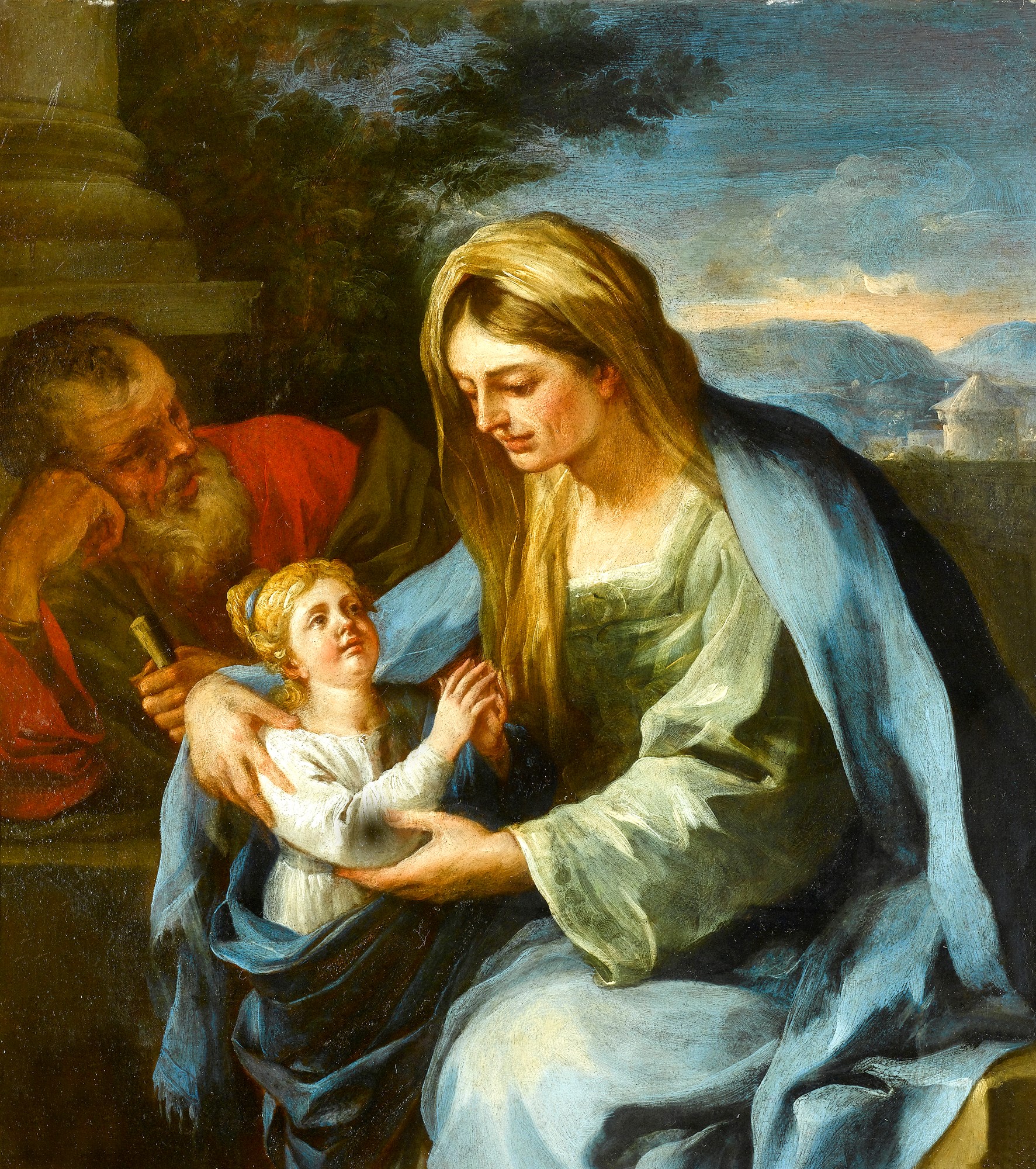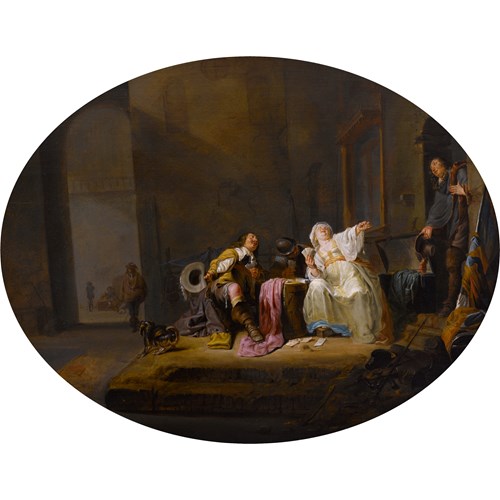Marketplace
St. Anne and the Virgin
Francesco Solimena
St. Anne and the Virgin
Period 1600-1750, 17th century, 18th century
Origin Italy
Medium Oil on copper
Dimension 35.2 x 31.7 cm (13⁷/₈ x 12¹/₂ inches)
Francesco Solimena’s depiction of Saints Anne and Joachim with the Virgin Mary expertly conveys familial affection and piety. The intimacy of the mother and child is evident as the father fondly looks on from a slight distance. According to the legend of the Virgin’s parentage, Joachim and Anne were a devout couple who were barren and approaching old age. After years of prayer, they were rewarded for their faith by the miraculous conception of Mary, their only child. In return, Anne promised to offer her daughter in service to the Temple in Jerusalem. St. Anne and the Virgin may depict the moment when the Virgin, aged three, took leave of her parents to go to Jerusalem.
St. Anne wears a subtle green dress with voluminous sleeves and an expansive blue mantle. She is the picture of modesty and the colours of her garments complement the gold of the cloth draped over her head, giving her an earthy, maternal charm. As she is usually clad in a red mantle, the choice of blue for St. Anne is unusual. Its pale hue however does not compete with the royal blue of her daughter’s mantle, the colour traditionally associated with the Virgin Mary. Underneath her blue mantle, the young Mary wears a simple white dress, symbolising purity, and clearly classically inspired, as is her hairstyle. She clasps her hands and raises them upwards as she looks into her mother’s eyes. Behind the pair, St. Joachim philosophically rests his head on his fist, holding a scroll in the other hand.
St Anne and the Virgin has been examined by Professor Nicola Spinosa, who has proposed that it is an example of Solimena’s early work. The artist’s attention is focused on the clarity of design and expression, derived from artists such as Annibale Carracci, Domenichino and Raphael. Great importance is placed on the gestures of the figures and sharpness of line. The harmony and tranquillity of the composition is in contrast to Solimena’s later work, which is marked by dramatic chiaroscuro and complexity. Both styles, however, are rooted in classicism.
Solimena's painting Allegory of Rule, part of the Stroganoff Collection in the Hermitage, is typical of his mature style, invoking the full theatricality of the Baroque style, with liberal employment of light and shade, action and expression. Allegory of Rule featured in the Hermitage’s exhibition The Stroganoffs: Art Patrons and Collectors (2003-04), accompanied by other paintings of outstanding quality. One of the exhibition’s themes focused on the Stroganoff family’s enduring love of classical antiquity, and one can image that Solimena’s work would have been particularly appealing because of its classical derivation.
Born in Canale di Serino and taught by his father in the naturalist tradition, Solimena was a prolific artist, who created frescoes, mythological scenes, portraits and religious paintings. He moved to Naples in 1674 where he studied the masterpieces of high Baroque art. After building his reputation with a number of religious and secular commissions, Solimena became the dominant figure in the Neopolitan school of painting in the first half of the eighteenth century. Although he spent the majority of his life in Naples, he became a highly influential artist throughout Europe. Solimena acquired great wealth, established his own academy, and was in constant demand by royal patrons, including Charles III of Spain, Prince Eugene of Savoy and Louis XIV of France.
St. Anne wears a subtle green dress with voluminous sleeves and an expansive blue mantle. She is the picture of modesty and the colours of her garments complement the gold of the cloth draped over her head, giving her an earthy, maternal charm. As she is usually clad in a red mantle, the choice of blue for St. Anne is unusual. Its pale hue however does not compete with the royal blue of her daughter’s mantle, the colour traditionally associated with the Virgin Mary. Underneath her blue mantle, the young Mary wears a simple white dress, symbolising purity, and clearly classically inspired, as is her hairstyle. She clasps her hands and raises them upwards as she looks into her mother’s eyes. Behind the pair, St. Joachim philosophically rests his head on his fist, holding a scroll in the other hand.
St Anne and the Virgin has been examined by Professor Nicola Spinosa, who has proposed that it is an example of Solimena’s early work. The artist’s attention is focused on the clarity of design and expression, derived from artists such as Annibale Carracci, Domenichino and Raphael. Great importance is placed on the gestures of the figures and sharpness of line. The harmony and tranquillity of the composition is in contrast to Solimena’s later work, which is marked by dramatic chiaroscuro and complexity. Both styles, however, are rooted in classicism.
Solimena's painting Allegory of Rule, part of the Stroganoff Collection in the Hermitage, is typical of his mature style, invoking the full theatricality of the Baroque style, with liberal employment of light and shade, action and expression. Allegory of Rule featured in the Hermitage’s exhibition The Stroganoffs: Art Patrons and Collectors (2003-04), accompanied by other paintings of outstanding quality. One of the exhibition’s themes focused on the Stroganoff family’s enduring love of classical antiquity, and one can image that Solimena’s work would have been particularly appealing because of its classical derivation.
Born in Canale di Serino and taught by his father in the naturalist tradition, Solimena was a prolific artist, who created frescoes, mythological scenes, portraits and religious paintings. He moved to Naples in 1674 where he studied the masterpieces of high Baroque art. After building his reputation with a number of religious and secular commissions, Solimena became the dominant figure in the Neopolitan school of painting in the first half of the eighteenth century. Although he spent the majority of his life in Naples, he became a highly influential artist throughout Europe. Solimena acquired great wealth, established his own academy, and was in constant demand by royal patrons, including Charles III of Spain, Prince Eugene of Savoy and Louis XIV of France.
Period: 1600-1750, 17th century, 18th century
Origin: Italy
Medium: Oil on copper
Dimension: 35.2 x 31.7 cm (13⁷/₈ x 12¹/₂ inches)
More artworks from the Gallery









